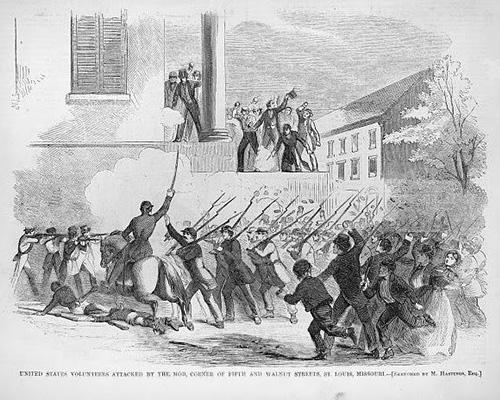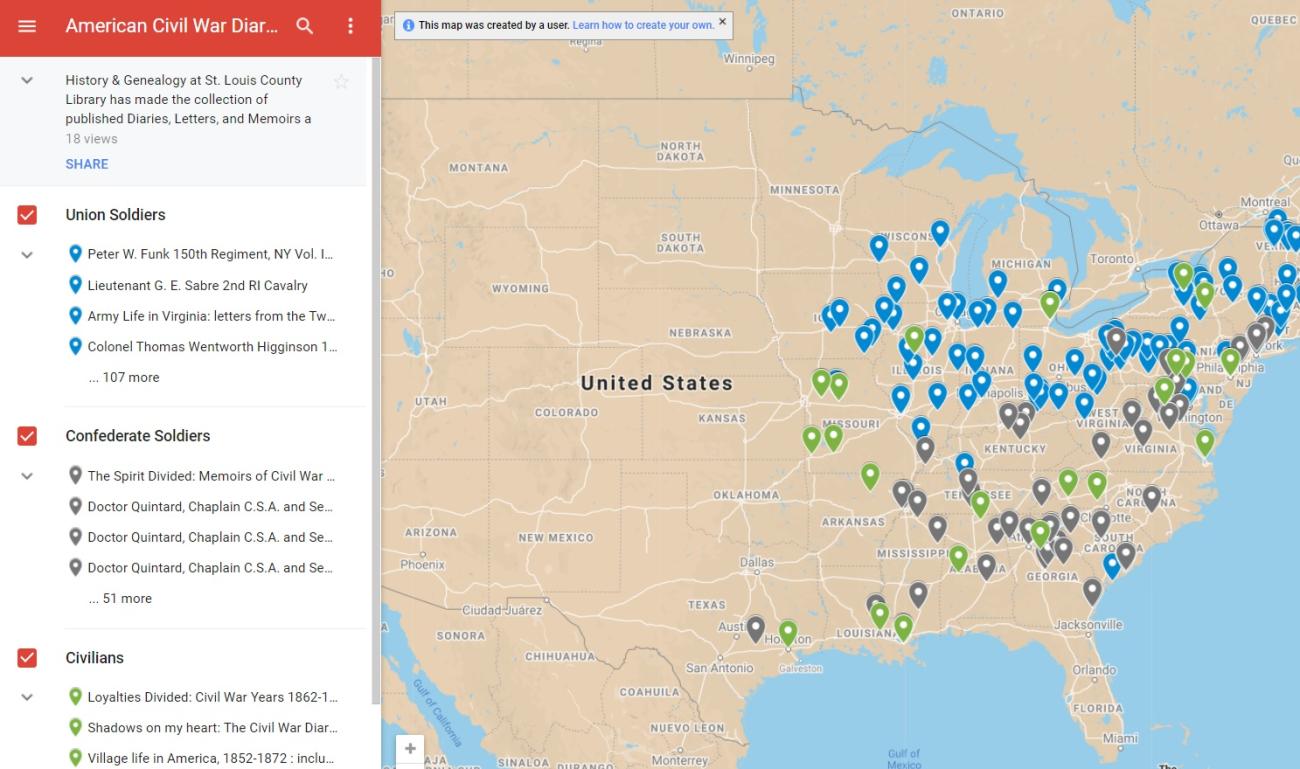American Civil War
The American Civil War is unquestionably the most written about event in American History. The Civil War was the first time in American history that governmental records and letters, diaries, and memoirs were produced in mass. This mass production of original source material has resulted in significant scholarship and a wide range of professional researchers and hobbyists producing published histories which explore the events, factors, and lives the civil war impacted.

For the Genealogist, the American Civil War presents a goldmine of historical information and facts that can be used to research ancestors and expand upon their experiences. History and Genealogy has long collected Civil War Research materials in support of genealogists and the Civil War has been a regular subject in our PastPorts Newsletter:
- Civil War St. Louis, PastPorts, Vol. 3, No. 4, April 2010
- Grand Army of the Republic, Pastports, Vol.10, No. 4, April 2018
- Civil War Research Brings Ancestors to Life, Vol. 10, No 10, October 2018
- St. Louis Germans and the Civil War in Missouri, Pastports, Vol. 11, No. 7. July 2019
History & Genealogy staff have made a concerted effort to expand Civil War collections to better aide researchers. Early collecting focused on large reference sets such as the Official Records of the Union and Confederate Armies. Today, we have a sizeable collection of published regimental histories, letters, diaries, memoirs, accounts, action and campaign histories, battle maps, and regional histories related to the Civil War era obtained from source publishers from all over the United States.
Bibliography of sources for Union Volunteer Units including histories, letters, diaries, memoirs, and biographies held and maintained by the library.
Resources for Union Regiments are divided into three categories:
What was a Slave Compensation Claim?
During the Civil War, two acts of Congress – one passed in 1864 (13 Stat. 11) and one in 1866 (14 Stat. 321) – allowed loyal slave owners whose slaves enlisted or were drafted into the U.S. military to file a claim against the Federal government for loss of the slave's services. The law allowed for up to $300 compensation for slaves who enlisted, and up $100 for slaves who were drafted. Although a third act of Congress passed in 1867 (15 Stat. 29) suspended the claims process, paperwork created by this claims process has survived.
The filmed Southern Claims Commission files for the approved claims for Alabama, Georgia, Virginia, and West Virginia, and for the barred and disallowed claims for the twelve states from which claims originated, are part of the Julius K. Hunter & Friends African American Research Collection in the History and Genealogy Department.
Background
Between 3 March 1871 and 3 March 1873, Southerners filed 22,298 claims before the Southern Claims Commission (SCC) based on the fact they:
- were loyal to the Union during the Civil War
- had quartermaster stores or supplies taken by or furnished to the Union Army during the rebellion (Later, materials supplied to or taken by the U.S. Navy were also included.)
More Information
Bleeding Kansas describes the period of repeated outbreaks of violent guerrilla warfare between pro-slavery and anti-slavery forces following the creation of the new territory of Kansas in 1854.
The Kansas-Nebraska act effectively repealed the Missouri Compromise - which had restricted slavery to states south of the 36º 30’ parallel - Missouri's Southern Border. This meant that white settlers could decide whether Kansas and Nebraska could enter the Union as a free or slave state.
The Bureau of Refugees, Freedmen, and Abandoned Lands (Record Group 105), also known as the Freedmen’s Bureau, was established in the War Department by an act of Congress on March 3, 1865. The Bureau was responsible for the supervision and management of all matters relating to the refugees and freedmen and lands abandoned or seized during the Civil War, duties previously shared by military commanders and US Treasury Department officials. In May 1865, President Andrew Johnson appointed Maj. Gen. Oliver Otis Howard as Commissioner of the Freedmen’s Bureau. Howard’s headquarters were in Washington, DC, but assistant commissioners, sub-assistant commissioners, and agents conducted the Bureau’s daily operations in the former Confederate states, the border states, and the District of Columbia.
Although the Bureau was not abolished until 1872, the bulk of its work was conducted from June 1865 to December 1868. While a major part of the Bureau’s early activities included the supervision of abandoned and confiscated property, its mission was to provide relief and help formerly enslaved people become self-sufficient.
Bureau functions included issuing rations and clothing, operating hospitals and refugee camps, and supervising labor contracts between planters and freedpeople. The Bureau also managed apprenticeship disputes and complaints, assisted benevolent societies in the establishment of schools, helped in legalizing marriages entered into during slavery, and provided transportation to refugees and freedpeople who were attempting to reunite with their family or relocate to other parts of the country. As Congress extended the life of the Bureau, it added other duties, such as assisting Black soldiers and sailors in obtaining back pay, bounty payments, and pensions.
Because the Bureau’s records contain a wide range of data about the African American experience during slavery and Reconstruction, they are an invaluable source for historians, social scientists, and genealogists.
In 2000, Julius K. Hunter and Friends invested in a collection of Genealogical Resources in Microfilm and Microfiche for the St. Louis County Library. Many of those films have been digitized and are now available through FamilySearch or Fold3. This includes the Applications for Headstones for U.S. Military Veterans, 1925–1941 – M1916.
In 2000, Julius K. Hunter and Friends invested in a collection of Genealogical Resources in Microfilm and Microfiche for the St. Louis County Library. Many of those films have been digitized and are now available through FamilySearch or Fold3. This includes all of the Compiled Military Service Records of Volunteer Union Soldiers who served with the U.S. Colored Troops (Civil War).
The Index to Compiled Service Records of Volunteer Union Soldiers who Served with the U.S. Colored troops is digitized and available from FamilySearch.
In 2000, Julius K. Hunter and Friends invested in a collection of Genealogical Resources in Microfilm and Microfiche for the St. Louis County Library. Many of those films have been digitized and are now available through FamilySearch or Fold3. This includes "Descriptive Recruitment Lists of Volunteers for the United States Colored Troops for the State of Missouri, 1863-1865" (NARA Microfilm Publication M1894 – 6 rolls)
FamilySearch has completed every name indexing of the records and are searchable.
Our librarians developed Indexes for these records. The indexes can be browsed alphabetically by slave owner’s name and alphabetical by name of recruit.
In 2000, Julius K. Hunter and Friends invested in a collection of Genealogical Resources in Microfilm and Microfiche for the St. Louis County Library. Many of those films have been digitized and are now available through FamilySearch or Fold3. This includes the Documents Relating to the Military and Naval Service of Blacks Awarded the Congressional Medal of Honor from the Civil War to Spanish American War (NARA M929)
In 2000, Julius K. Hunter and Friends invested in a collection of Genealogical Resources in Microfilm and Microfiche for the St. Louis County Library. Many of those films have been digitized and are now available through FamilySearch or Fold3. This includes the Organization Index to Pension Files of Veterans Who Served Between 1861 and 1900 (NARA Microfilm Publication T289)
Important to Note: Rolls 540-579 covered Colored Troops
In 2000, Julius K. Hunter and Friends invested in a collection of Genealogical Resources in Microfilm and Microfiche for the St. Louis County Library. Many of those films have been digitized and are now available through FamilySearch or Fold3. This includes the Registers of Enlistments in the United States Army, 1798-1914 (NARA Microfilm Publication M233)

